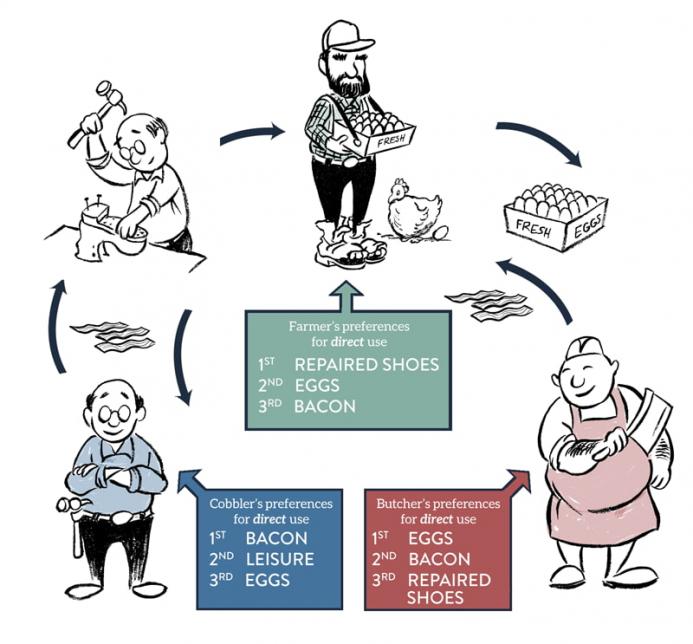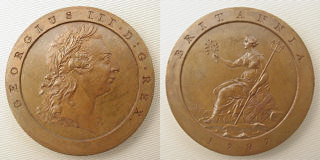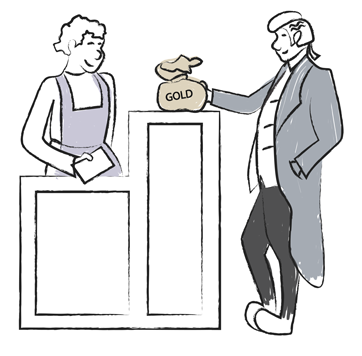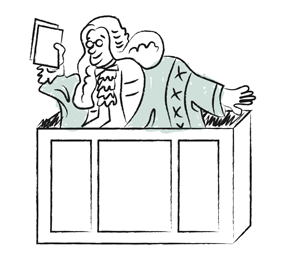[This article is part of the Understanding Money Mechanics series, by Robert P. Murphy. The series will be published as a book in late 2020.]
The ultimate purpose of this booklet is to give the reader a solid grasp of how money works in today’s world. Yet before diving into the particulars of central banks, repo markets, and LIBOR—all topics that will be covered in future chapters—we should first provide a general framework giving the basic theory or “economic logic” of money and banking.
In short: why do we have money in the first place? Where does it come from, and what determines its form (livestock, metal ingots, coins, paper notes, electronic ledger entries, etc.)? What qualities make for a good money? What role do banks play—is it something other than what money itself does for us?
In this chapter, we’ll answer these elementary yet essential questions. To be clear, we are not here offering an actual history lesson, though we do mention some important historical episodes and illustrative examples. Rather we are providing a mental framework for understanding everything else that follows in the booklet.
The Limits of Direct Exchange
To understand the importance of money, let’s first imagine a society without money. In a world limited to barter, or what economists more precisely call direct exchange, there would still be private property and people would still benefit from voluntary trade. Because economic value is subjective—the “utility” of a good is in the eye (or mind) of the beholder—we can have win-win exchanges, in which both parties walk away correctly believing that they got the better end of the deal.
However, if society were limited to direct exchange—in which individuals only accept items in trade that they plan on using personally—then people would miss out on many advantageous transactions. Let’s consider a simplistic example. Suppose there are three individuals: a farmer, a butcher, and a cobbler. The farmer starts out with some eggs that he’s just taken from his hens. He would like to trade his eggs in order to get his tattered shoes repaired. The problem, though, is that the cobbler doesn’t want any eggs—but he would be willing to repair the shoes for bacon.
Unfortunately, the farmer doesn’t currently have bacon. However, his neighbor the butcher does have bacon. Yet the butcher doesn’t want to trade with the cobbler, because the butcher’s shoes are just fine. What the butcher would really like are some eggs. Yet, the farmer himself doesn’t like the taste of bacon, and would rather eat his own eggs.
In a world limited to direct exchange, these men are at an impasse, because no single transaction would benefit any pair of them. Yet all of them could improve their situation with a rearrangement of the goods.
The solution is to introduce indirect exchange, in which at least one person accepts an item in trade that he doesn’t plan on using himself but holds merely to trade away again in the future. In our example, suppose that the farmer has an epiphany: Even though he personally dislikes its taste, he trades his eggs to the butcher to obtain the bacon. Then he takes the bacon to the cobbler, who accepts it as payment for fixing his tattered shoes.
After these two trades, all three individuals are better off than they were originally. Remember, though, that the solution relied on the farmer accepting an item in trade—in this case the bacon—that he didn’t plan on using himself. Economists call such a good a medium of exchange. Just as air is a “medium” through which sound waves travel, the bacon served as a medium through which the farmer’s ultimate exchange was effected—namely giving up his eggs in order to receive shoe-repair services.
Media of Exchange and the Origin of Money
As our fable illustrated, individuals can often improve their position by trading away goods that are less marketable and accepting goods that are more marketable, even if they don’t personally plan on using the items. As the founder of the Austrian school, Carl Menger, demonstrated in an 1892 essay1 (though earlier economists had anticipated some of the explanation), this principle is all we need to explain the emergence of money.
As individuals in the community seek to trade away their less marketable (or less liquid) goods in exchange for more marketable (or more liquid) goods, a snowball process is set in motion: those goods that started out with a wide appeal based on their intrinsic qualities see a boost in their popularity simply because they are so popular. (For a more modern example, the prisoners in a World War II POW camp would gladly trade away their rations in exchange for cigarettes even if they were nonsmokers, because enough of the other prisoners were smokers.2) Eventually, one or two commodities become so popular that just about everyone in the community would be willing to accept them in trade. At that point, money has been born.
A formal definition for money is that it’s a universally accepted medium of exchange. Menger’s explanation showed how such a commodity could emerge from its peers merely through voluntary transactions and without any individual seeing the big picture or trying to “invent” money. (See the endnotes for recent anthropological criticism of Mengerian-type explanations of the origin of money.3)
The Qualities of a Good (Commodity) Money
Money that emerged in the process we’ve described would necessarily be commodity money, in which the monetary good itself is also a regular commodity. (In Chapter 3 we will discuss fiat money, in which the monetary good serves no other function than to be the money.) Historically, many types of commodities have served as money in various regions, including livestock, shells, tobacco, and of course the precious metals gold and silver.
What would make a community gravitate towards some commodities but not others? Besides having a wide marketability, an individual would want a medium of exchange to possess the following qualities: ease of transport, durability, divisibility, homogeneity, and convenient size and weight for the intended transactions.
In our fable above, although bacon served as the medium of exchange, it would be ill-suited to serve this purpose generally, as bacon is perishable. Likewise, a shotgun might be very valuable in certain communities, but it’s not divisible; you can’t cut it in half to “make change.” Diamonds might seem like a great candidate for a medium of exchange, but they aren’t homogeneous: one giant diamond is more valuable than five smaller diamonds that (combined) weigh the same amount.
These types of considerations help explain why eventually gold and silver emerged as the market’s commodity monies of choice. These precious metals satisfied all of the criteria of what makes a convenient medium of exchange, and once the community generally agreed, they were money.
Monetary Calculation
The emergence of money meant that a single commodity was on one side of every transaction. This greatly reduced the calculations required to navigate the marketplace. For example, consider a merchant whose business required him to closely follow twenty different goods. In a world of pure barter—where each good traded directly against every other good—in principle he would have to keep track of 190 separate barter “prices”4 (meaning the ratios at which one good traded for another). But if one of those twenty goods also serves as the monetary good—maybe it’s silver—then the merchant only needs to keep track of nineteen different prices (all quoted in silver), because each of the other goods is always being bought and sold against silver.
Moving from a state of barter to a monetary economy allows for economic decisions to be appraised in terms of a standard unit. With the use of money, business owners can engage in accounting, where they can easily calculate whether they had a profitable year. Trying to compare revenues to expenses would be much more difficult in a pure barter system. A factory owner could know that her operation used up certain quantities of hundreds of input commodities (including labor hours), in order to produce certain quantities of dozens of outputs, but without being able to reckon these physically distinct commodities in terms of money prices, she would face the same type of problem plaguing socialist central planners.5
The Function of Monetary Coins (and Tokens)
We have seen how a commodity money can emerge spontaneously from a prior state of barter, facilitating exchanges and profit/loss calculations. However, even though a community benefits tremendously from the existence of money, there would still be limitations if the money remained in its “raw” form. It would hamper trade if shopkeepers had to perform metallurgical tests on hunks of metal that customers presented for payment to verify that the hunks were indeed silver (or gold, etc.) of the claimed weight.
The solution to this problem is to coin the raw hunks of metal into recognizable disks of a uniform size and purity (or “fineness”). We should emphasize that a full-bodied coin was not money because of the stamping process; the markings on the coin merely indicated to the community that the hunk of metal in question did indeed contain the specified weight in the underlying commodity that served as money.
In addition to striking full-bodied coins, another possible solution is for reputable outlets to issue token coins, which represent redemption claims on the issuer for a specified amount of the actual money commodity. Note that to perform their function well, even token coins would need to be recognizable in the community and difficult to counterfeit. For a modern example, consider the plastic chips issued by casinos: A Las Vegas casino needs to have chips that are distinctive and “authentic”-looking, and which can’t be easy for outsiders to replicate. Because such chips will be instantly redeemed by the casino, within its walls (and even perhaps in the surrounding neighborhood) they are “as good as money.” But a gambler who travels back home wouldn’t be able to buy groceries with chips issued from a Las Vegas casino.
Just as the money itself can arise without the intervention of political authorities, so too can the private sector handle the operations of turning the commodity money into coins. Indeed, numismatists agree that some of the highest-quality coins (and tokens) ever produced originated in eighteenth-century Britain from private mints.
The full story is too long to tell here,6 but the quick version is that the British Royal Mint had utterly failed to provide the common people with coins that could serve their needs for everyday commerce, and regulations prohibited banks from issuing notes in small denominations. As a result, employers resorted to various inconvenient remedies, including paying their workers in waves (so that, say, the first third of the employees would spend their new wages in town, after which the employers could then collect the coins in order to pay the second third of their workers, etc.) and making arrangements with the local tavern owners so that the workers’ beer tabs would effectively reduce the wages they were owed. The shortage of government-produced coinage was so severe that even obviously counterfeit coins were tolerated because bad money was better than no money at all.
In this intolerable situation, Thomas Williams, the principal owner of the giant Parys copper mine, hit upon the bright idea of installing a commercial-scale mint on the premises. He then struck (token) coins out of the copper with instructions on where they could be redeemed for money, and paid his workers—the ones actually mining the copper—with these token coins. Soon afterwards Matthew Boulton, famous for his collaboration with James Watt in the refinement of the modern steam engine, followed suit with the privately owned Soho Mint, where he was the first to implement a process of using steam power to mass-produce exquisite coinage. The following photos exhibit the remarkable craftsmanship of the privately struck coins and tokens from this era.7
A Penny from a Soho Mint 1797 pattern striking. Photo Credit: Bill McKivor, The Copper Corner.
A 1791 token promising a half-penny to the bearer. Photo Credit: Bill McKivor, The Copper Corner.
The Function and Origin of Banks
Even in a community with a commodity money stamped into high-quality coins, there would still be limitations on commerce. For example, wealthy individuals would be nervous about holding vast sums of gold or silver in their homes where they would be vulnerable to theft, and it would be inconvenient to transport large amounts of coin or bullion for every transaction involving a significant purchase price.
A bank solves these problems by providing a secure location where members of the community can store their excess supplies of money. (The other main function of banks is to serve as credit intermediaries, which act as a conduit between borrowers and savers.) The goldsmith was a logical person to also act as banker, because his business already involved storing stockpiles of gold. It was easy enough for members of the community to deposit coins with the goldsmith in exchange for an official receipt indicating how much of the money commodity they (the depositors) had stored with him.
The reason a booklet on the mechanics of money must also cover banking is that—to put it bluntly—banks enjoy the legal ability to create money. In Chapter 5 we will explain this process in much greater detail, but for now let us quote the Chicago Federal Reserve on the historical origins (at least in England) of this practice:
[B]anks can build up deposits by increasing loans and investments so long as they keep enough currency on hand to redeem whatever amounts the holders of deposits want to convert into currency. This unique attribute of the banking business was discovered many centuries ago.It started with goldsmiths. As early bankers, they initially provided safekeeping services, making a profit from vault storage fees for gold and coins deposited with them. People would redeem their “deposit receipts” whenever they needed gold or coins to purchase something, and physically take the gold or coins to the seller who, in turn, would deposit them for safekeeping, often with the same banker. Everyone soon found that it was a lot easier simply to use the deposit receipts directly as a means of payment. These receipts, which became known as notes, were acceptable as money since whoever held them could go to the banker and exchange them for metallic money.
Then, bankers discovered that they could make loans merely by giving their promises to pay, or bank notes, to borrowers. In this way, banks began to create money. More notes could be issued than the gold and coin on hand because only a portion of the notes outstanding would be presented for payment at any one time. Enough metallic money had to be kept on hand, of course, to redeem whatever volume of notes was presented for payment. [Emphasis added.]8
Once the banker (such as the goldsmith) realized that his deposit receipts (“notes”) were treated by at least some members of the community as being “as good as money,” he could lend out some of the coins that his customers had deposited with him, even though the customers still held paper receipts entitling them to immediate redemption. The whole operation was viable so long as the banker always had enough coins on hand to satisfy whoever might show up to demand their deposits back.
This booklet will focus on the mechanics and economic implications of the fact that banks have the legal ability to create money, but we’ll wrap up our historical sketch here with a note on the judicial treatment. If someone hands over an item for safekeeping in which the specific article is important—such as a college student placing her furniture in a storage unit for the summer, or a diner checking his coat when entering a restaurant—this is handled under bailment law. In such a situation, the person acting as a warehouser obtains physical possession but not legal ownership of the items in question, and is obligated to act as their custodian until the actual owner wishes to retrieve them. It would be a breach of contract for the manager of a storage facility to rent out the student’s couch, even if he had it safely back in her storage unit when she returned from summer break.
However, when the deposited items are fungible goods, such as wheat or oil, then the relationship is more nuanced. With such an “irregular deposit,” the depositor isn’t entitled to the specific physical items that were handed over for safekeeping, but instead merely expects to receive comparable items back. In the typical scenario, this is the type of deposit applicable to money; the people handing over coins to the goldsmith didn’t care about receiving back those particular coins, they merely wanted to be assured of obtaining the same number of comparable coins when they redeemed their deposit receipts (i.e., banknotes).
As a result of various court rulings, it is now standard to treat the deposit of money with a bank as a loan, so that the depositor becomes a creditor of the bank and the actual ownership of the money transfers to the banker, even for “demand deposits,” which are payable upon notice. Rightly or wrongly,9 it is this legal treatment that allowed the proverbial goldsmith to lend out some of the coins that his depositors had placed with him for safekeeping, and which allows modern banks to engage in “fractional reserve banking.” To reiterate, it is this practice by which banks can create (and destroy) money—a process that we will fully explain in Chapter 5.
We will close this chapter with an excerpt from an opinion issued by Lord Cottenham in the 1848 case Foley v. Hill and Others:
The money placed in the custody of a banker is, to all intents and purposes, the money of the banker, to do with as he pleases; he is guilty of no breach of trust in employing it; he is not answerable to the principal if he puts it into jeopardy, if he engages in a hazardous speculation; he is not bound to keep it or deal with it as the property of his principal; but he is, of course, answerable for the amount, because he has contracted.10
- 1.Carl Menger, “On the Origins of Money,” Economic Journal 2 (1892): 239–55, https://cdn.mises.org/On%20the%20Origins%20of%20Money_5.pdf.
- 2.The classic article from a trained economist captured by the enemy in World War II is: R. A. Radford, “The Economic Organization of a P.O.W. Camp,” Economica 12, no. 48 (November 1945): 189–201, http://icm.clsbe.lisboa.ucp.pt/docentes/url/jcn/ie2/0POWCamp.pdf.
- 3.The most prominent modern critic of the standard “economistic” explanation for money is David Graeber, in his Debt: The First Five Thousand Years (Brooklyn, NY: Melville House Publishing, 2011). For a review of Graeber’s critique and a defense of the Mengerian approach, see Robert Murphy, “Origin of the Specie,” American Conservative, Apr. 11, 2012, https://www.theamericanconservative.com/articles/origin-of-the-specie/.
- 4.For n goods, there are n*(n–1)/2 unique barter price ratios.
- 5.Ludwig von Mises is the economist whose 1920 essay launched what has become known as the “socialist calculation debate.” He stressed the crucial function of economic calculation in guiding entrepreneurs in a market economy, so that they could assess whether their operations were using scarce resources for socially beneficial purposes. For an accessible discussion see Murray Rothbard, “The End of Socialism and the Calculation Debate Revisited,” Review of Austrian Economics 5, no. 2 (1991): 51–76, https://cdn.mises.org/rae5_2_3_2.pdf.
- 6.The details of Britain’s coin shortage and the private-mint response are taken from George Selgin, Good Money (Oakland, CA: Independent Institute, 2008), chapters 1 and 2.
- 7.The photos are gratefully used with permission from Bill McKivor, whose website (featuring these and other photos) is http://www.thecoppercorner.com/.
- 8.Dorothy M. Nichols, Modern Money Mechanics: A Workbook on Bank Reserves and Deposit Expansion, rev. Anne Marie L. Gonczy, rev. ed. (1961; Chicago: Federal Reserve Bank of Chicago, 1994), p. 3, available at: https://upload.wikimedia.org/wikipedia/commons/4/4a/Modern_Money_Mechanics.pdf.
- 9.For an elaborate case arguing against the practice of fractional reserve banking on both (traditional) legal and economic grounds, see Jesús Huerta de Soto, Money, Bank Credit, and Economic Cycles, trans. Melinda A. Stroup, (1998; Auburn, AL: Ludwig von Mises Institute, 2006), available at https://cdn.mises.org/Money_Bank_Credit_and_Economic_Cycles_De%20Soto.pdf. For a defense of the development of the legal treatment of fractional reserve banking, see George Selgin, “Those Dishonest Goldsmiths,” SSRN Working Paper, Apr. 14, 2010, https://papers.ssrn.com/sol3/papers.cfm?abstract_id=1589709.
- 10.Foley v. Hill and Others, 2 H.L.C. 28, 9 E.R. 1002 (1848), quoted in Murray N. Rothbard, The Case Against the Fed (1994; repr. Auburn, AL: Ludwig von Mises Institute, 2007), pp. 42–43, available at: https://cdn.mises.org/The%20Case%20Against%20the%20Fed_3.pdf.







